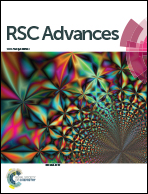Protic ionic liquid [TMG][Ac] as an efficient, homogeneous and recyclable catalyst for one-pot four-component synthesis of 2H-indazolo[2,1-b]phthalazine-triones and dihydro-1H-pyrano[2,3-c]pyrazol-6-ones
Abstract
The mildly basic ionic liquid N,N,N,N-tetramethylguanidinium acetate [TMG][Ac] was found to be a very effective basic catalyst for the one-pot, four-component synthesis of 2H-indazolo[2,1-b]phthalazine-triones by condensation of phthalic anhydride, hydrazinium hydroxide, aromatic aldehydes, and dimedone in high yields at 80 °C. [TMG][Ac] catalyzed simple and efficient one-pot four-component reaction of Meldrums acid, ethyl acetoacetate, hydrazine hydrate, and aromatic aldehydes to give dihydro-1H-pyrano[2,3-c]pyrazol-6-ones is reported. The ionic liquid could be recycled several times without loss of efficiency with regards to the reaction times and yields.
![Graphical abstract: Protic ionic liquid [TMG][Ac] as an efficient, homogeneous and recyclable catalyst for one-pot four-component synthesis of 2H-indazolo[2,1-b]phthalazine-triones and dihydro-1H-pyrano[2,3-c]pyrazol-6-ones](/en/Image/Get?imageInfo.ImageType=GA&imageInfo.ImageIdentifier.ManuscriptID=C4RA03514C&imageInfo.ImageIdentifier.Year=2014)

 Please wait while we load your content...
Please wait while we load your content...